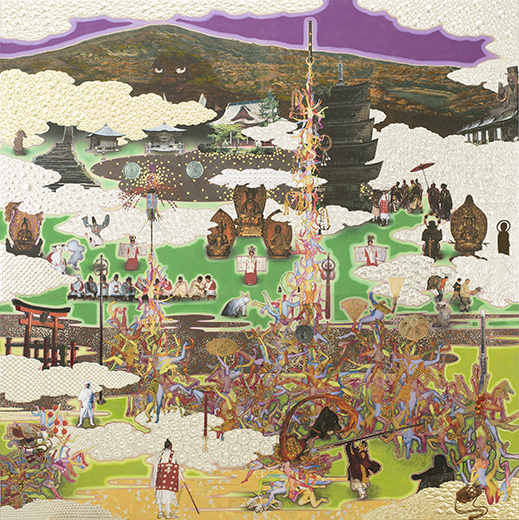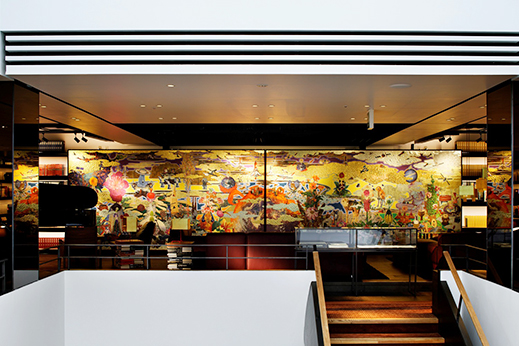 |
|
Here and There introduces art, artists, galleries and museums around Japan that non-Japanese readers and first-time visitors may find of particular interest. The writer claims no art expertise, just a subjective viewpoint acquired over many years' residence in Japan.
|
|
 |
|
|
 |
 |
You Can't Go Home Again: Masatake Kozaki at Art Front Gallery
Alan Gleason |
 |
|
Installation view, Becoming Place: Masatake Kozaki at Art Front Gallery |
Masatake Kozaki gleefully wields an impressive arsenal of materials and techniques old and new, all with the confidence of a master. His influences are equally protean, ranging from the curious Nanban depictions of European culture by 16th-century artists and the Edo-period (1603-1867) scroll paintings of the Hyakki yagyo (Night Parade of 100 Demons) to Hieronymus Bosch's Garden of Earthly Delights. He paints on traditional hemp paper with mineral pigments, but mixes them with acrylics. He favors the roiling gold- and silver-foil cloud motifs that dominate screen paintings like the glorious 17th-century Rakuchu rakugai zu panoramas of Kyoto -- but his subject matter is anything but orthodox.
|
TOUGEN Osawa 1 (2013), panel, hemp paper, mineral pigment, acrylic, foil, 810 x 1620 mm |
|
TOUGEN Chimera (2016), panel, hemp paper, mineral pigment, acrylic, foil, 810 x 1620 mm |
A case in point is the TOUGEN series prominently featured in Becoming Place, his current show at Tokyo's Art Front Gallery. The title derives from Tougenkyo, the Japanese name for a Shangri-la-like earthly paradise mentioned in classical Chinese literature. Kozaki's utopias, however, are pastiches of bizarre flora and fauna, fanciful creatures he dubs "chimera," Buddhas with rooster heads, spaceships and planets careening hither and yon, and other madcap juxtapositions of ancient and modern, fish and fowl. If the word "mutant" springs to mind, there are darker reasons for that association.
|
Statue of Buddha in Jionji Temple (2016), panel, hemp paper, mineral pigment, acrylic, foil, 530 x 530 mm |
Born in 1972, Kozaki was raised in Futaba, the locality where the melted-down reactors of the Fukushima Daiichi Nuclear Plant began spewing radiation in March 2011, rendering his hometown uninhabitable. Though his work contains no explicit allusions to the disaster or its personal ramifications, a restless, complex energy imbues it -- an irreconcilable tension between ideals and frustration, hope and despair, given shape in fusions of disparate motifs that seem on the verge of exploding.
|
Makyo Daruma (2013), panel, hemp paper, mineral pigment, acrylic, foil, 810 x 1620 mm |
|
Hijiori Kokeshi (2016), panel, hemp paper, mineral pigment, acrylic, foil, 1000 x 1000 mm |
The tragedy of Futaba is, however, obliquely referenced by a series of works in which Kozaki highlights cultural artifacts of the community and of the greater Tohoku region (he teaches at the Tohoku University of Art and Design in Yamagata). Noteworthy are his paintings of collages of traditional Daruma and Kokeshi dolls, in which the whimsical figures float on clouds of gold and silver foil embossed with tiny doll patterns. As in Kozaki's other works, the cloud elements stand out in bold relief, threatening to eclipse the flatter picture plane, which at times resembles a photomontage of magazine cutouts. In Hikyo Haguro, he faithfully reproduces cut-out snapshots of Buddhist temples, pagodas, and statuary atop Yamagata's sacred Mount Haguro, but surrounds them with serpentine "ropes" consisting of nude female bodies. Kozaki's work conjures up a world that, like his hometown, is buffeted by powerful forces colliding in a conflict that may never be resolved.
 |
|
Hikyo Haguro (2013), panel, hemp paper, mineral pigment, acrylic, foil, 1620 x 1620 mm; photography by Masatoshi Naito
|
Located in Tokyo's fashionable Daikanyama district, Art Front Gallery occupies a corner of Hillside Terrace, a sprawling mixed-use cultural complex designed by prizewinning architect Fumihiko Maki and built in stages from the late 1960s into the early 90s. Chaired by Fram Kitagawa, the gallery serves as the Tokyo base for the art-festival impresario's ambitious projects in more outlying parts of Japan -- most notably the Echigo-Tsumari Triennale that Kitagawa founded in his home prefecture of Niigata. Another Kitagawa brainchild currently in progress, the Setouchi Triennale, offers a smorgasbord of art installations and events on islands scattered across the Seto Inland Sea.
A massive screen painting by Kozaki from his TOUGEN series is on permanent display just down the street from Hillside Terrace in Lounge Anjin at Daikanyama Tsutaya Bookstore, another cultural watering hole that is worth a visit while one is in the neighborhood.
 |
|
TOUGEN: Beyond the Foresight (2011), mineral pigment, gold foil on Japanese paper, panel, 8780 x 2315 mm; installation at Lounge Anjin, Daikanyama Tsutaya Bookstore. Photo by Nacàsa & Partners Inc., courtesy of Lounge Anjin
All works by Masatake Kozaki; images courtesy of Art Front Gallery.
|
 |
|
| |
Hillside Terrace A, 29-18 Sarugaku-cho, Shibuya-ku, Tokyo
Phone: 03-3476-4869
Hours: 11 a.m. to 7 p.m.; closed Mondays and 13-14 August
Access: 5 minutes' walk from Daikanyama Station on the Tokyu Toyoko Line |
|
|
| |
 |
Alan Gleason
Alan Gleason is a translator, editor and writer based in Tokyo, where he has lived for 30 years. In addition to writing about the Japanese art scene he has edited and translated works on Japanese theater (from kabuki to the avant-garde) and music (both traditional and contemporary). |
|
|
|
|
|
|
|
|
|
 |
|